Short-Term Effects of Olive-Pomace-Based Conditioners on Soil Aggregation Stability
Abstract
:1. Introduction
2. Materials and Methods
2.1. Soil Sampling and Characterization
2.2. Olive-Pomace-Based Organic Conditioners (OPC)
2.3. Experimental Design and Aggregate Stability (AS) Determination
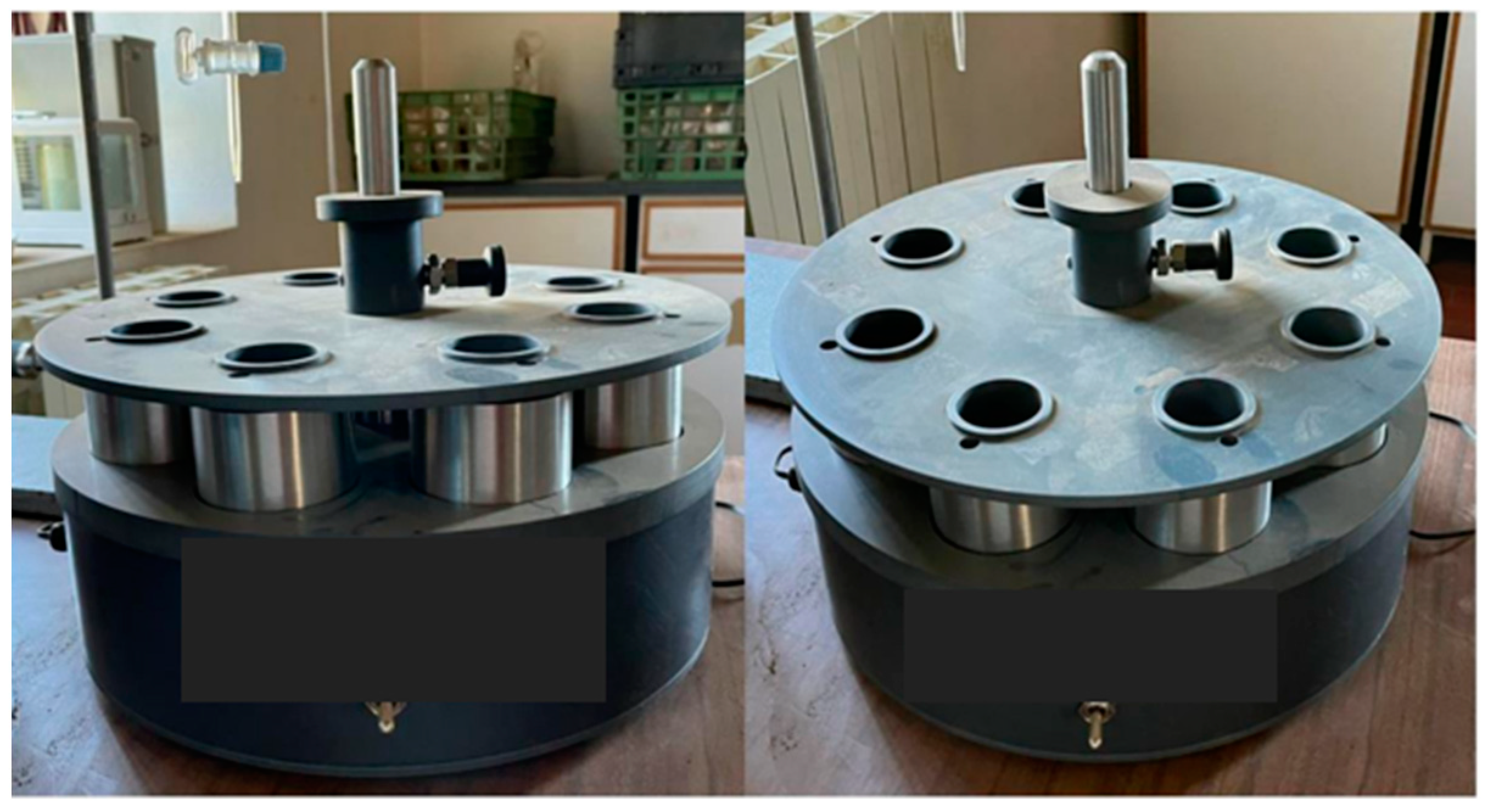
2.4. Statistical Analysis
3. Results
3.1. Relative Importance of Factors Affecting Aggregate Stability
3.2. Effects of Compost Characteristics on Soil Aggregate Stability
3.2.1. Compost Grain Size
3.2.2. Compost Dose and Maturity
4. Discussion
5. Conclusions
Author Contributions
Funding
Data Availability Statement
Acknowledgments
Conflicts of Interest
References
- FAO. Status of the World’s Soil Resources: Main Report; Food and Agriculture Organization of the United Nations and Intergovernmental Technical Panel on Soils; FAO: Rome, Italy, 2015; ISBN 978-9-25109-004-6. [Google Scholar]
- Mataix-Solera, J.; Cerdà, A.; Arcenegui, V.; Jordán, A.; Zavala, L.M. Fire Effects on Soil Aggregation: A Review. Earth Sci. Rev. 2011, 109, 44–60. [Google Scholar] [CrossRef]
- Nciizah, A.D.; Wakindiki, I.I. Aggregate Breakdown Mechanisms as Affected by Soil Texture and Organic Matter in Soils Dominated by Primary Minerals. S. Afr. J. Plant Soil 2014, 31, 213–218. [Google Scholar] [CrossRef]
- Bronick, C.J.; Lal, R. Soil Structure and Management: A Review. Geoderma 2005, 124, 3–22. [Google Scholar] [CrossRef]
- Legout, C.; Leguédois, S.; Le Bissonnais, Y. Aggregate Breakdown Dynamics under Rainfall Compared with Aggregate Stability Measurements. Eur. J. Soil Sci. 2005, 56, 225–238. [Google Scholar] [CrossRef]
- Sarker, T.C.; Zotti, M.; Fang, Y.; Giannino, F.; Mazzoleni, S.; Bonanomi, G.; Cai, Y.; Chang, S.X. Soil Aggregation in Relation to Organic Amendment: A Synthesis. J. Soil Sci. Plant Nutr. 2022, 22, 2481–2502. [Google Scholar] [CrossRef]
- Oades, J.M. Soil Organic Matter and Structural Stability: Mechanisms and Implications for Management. Plant Soil 1984, 76, 319–337. [Google Scholar] [CrossRef]
- Six, J.; Bossuyt, H.; Degryze, S.; Denef, K. A History of Research on the Link between (Micro)Aggregates, Soil Biota, and Soil Organic Matter Dynamics. Soil Tillage Res. 2004, 79, 7–31. [Google Scholar] [CrossRef]
- Lehmann, A.; Leifheit, E.F.; Rillig, M.C. Mycorrhizas and Soil Aggregation. In Mycorrhizal Mediation of Soil; Elsevier: Amsterdam, The Netherlands, 2017; pp. 241–262. ISBN 978-0-12804-312-7. [Google Scholar]
- Oades, J.M. The Role of Biology in the Formation, Stabilization and Degradation of Soil Structure. In Soil Structure/Soil Biota Interrelationships; Brussaard, L., Kooistra, M.J., Eds.; Elsevier: Amsterdam, The Netherlands, 1993; pp. 377–400. ISBN 978-0-44481-490-6. [Google Scholar]
- Oades, J.M.; Waters, A.G. Aggregate Hierarchy in Soils. Soil Res. 1991, 29, 815–828. [Google Scholar] [CrossRef]
- Ribeiro, B.T.; de Lima, J.M.; Curi, N.; de Oliveira, G.C. Aggregate Breakdown and Dispersion of Soil Samples Amended with Sugarcane Vinasse. Sci. Agric. 2013, 70, 435–441. [Google Scholar] [CrossRef]
- John, B.; Yamashita, T.; Ludwig, B.; Flessa, H. Storage of Organic Carbon in Aggregate and Density Fractions of Silty Soils under Different Types of Land Use. Geoderma 2005, 128, 63–79. [Google Scholar] [CrossRef]
- Pagliai, M.; Vignozzi, N.; Pellegrini, S. Soil Structure and the Effect of Management Practices. Soil Tillage Res. 2004, 79, 131–143. [Google Scholar] [CrossRef]
- Tisdall, J.M.; Oades, J.M. Organic Matter and Water-Stable Aggregates in Soils. J. Soil Sci. 1982, 33, 141–163. [Google Scholar] [CrossRef]
- Abiven, S.; Menasseri, S.; Chenu, C. The Effects of Organic Inputs over Time on Soil Aggregate Stability—A Literature Analysis. Soil Biol. Biochem. 2009, 41, 1–12. [Google Scholar] [CrossRef]
- Piccolo, A.; Mbagwu, J.S.C. Role of Hydrophobic Components of Soil Organic Matter in Soil Aggregate Stability. Soil Sci. Soc. Am. J. 1999, 63, 1801–1810. [Google Scholar] [CrossRef]
- Nicolás, C.; Kennedy, J.N.; Hernández, T.; García, C.; Six, J. Soil Aggregation in a Semiarid Soil Amended with Composted and Non-Composted Sewage Sludge—A Field Experiment. Geoderma 2014, 219–220, 24–31. [Google Scholar] [CrossRef]
- Paradelo, R.; Lerch, T.Z.; Houot, S.; Dignac, M.-F. Composting Modifies the Patterns of Incorporation of OC and N from Plant Residues into Soil Aggregates. Geoderma 2019, 353, 415–422. [Google Scholar] [CrossRef]
- Fernández, J.M.; López-de-Sá, E.G.; Polo, A.; Plaza, C. Short-Term Stabilization of Organic Matter in Physically, Chemically, and Biochemically Protected Pools in Soils Amended with Municipal Wastes. CLEAN Soil Air Water 2014, 42, 487–493. [Google Scholar] [CrossRef]
- Puget, P.; Chenu, C.; Balesdent, J. Dynamics of Soil Organic Matter Associated with Particle-Size Fractions of Water-Stable Aggregates. Eur. J. Soil Sci. 2000, 51, 595–605. [Google Scholar] [CrossRef]
- Ghosh, B.N.; Meena, V.S.; Singh, R.J.; Alam, N.M.; Patra, S.; Bhattacharyya, R.; Sharma, N.K.; Dadhwal, K.S.; Mishra, P.K. Effects of Fertilization on Soil Aggregation, Carbon Distribution and Carbon Management Index of Maize-Wheat Rotation in the North-Western Indian Himalayas. Ecol. Indic. 2019, 105, 415–424. [Google Scholar] [CrossRef]
- Grosbellet, C.; Vidal-Beaudet, L.; Caubel, V.; Charpentier, S. Improvement of Soil Structure Formation by Degradation of Coarse Organic Matter. Geoderma 2011, 162, 27–38. [Google Scholar] [CrossRef]
- Six, J.; Conant, R.T.; Paul, E.A.; Paustian, K. Stabilization Mechanisms of Soil Organic Matter: Implications for C-Saturation of Soils. Plant Soil 2002, 241, 155–176. [Google Scholar] [CrossRef]
- Schmidt, M.W.I.; Torn, M.S.; Abiven, S.; Dittmar, T.; Guggenberger, G.; Janssens, I.A.; Kleber, M.; Kögel-Knabner, I.; Lehmann, J.; Manning, D.A.C.; et al. Persistence of Soil Organic Matter as an Ecosystem Property. Nature 2011, 478, 49–56. [Google Scholar] [CrossRef] [PubMed]
- Bucka, F.B.; Felde, V.J.M.N.L.; Peth, S.; Kögel-Knabner, I. Disentangling the Effects of OM Quality and Soil Texture on Microbially Mediated Structure Formation in Artificial Model Soils. Geoderma 2021, 403, 115213. [Google Scholar] [CrossRef]
- De Gryze, S.; Six, J.; Brits, C.; Merckx, R. A Quantification of Short-Term Macroaggregate Dynamics: Influences of Wheat Residue Input and Texture. Soil Biol. Biochem. 2005, 37, 55–66. [Google Scholar] [CrossRef]
- Abiven, S.; Menasseri, S.; Angers, D.A.; Leterme, P. Dynamics of Aggregate Stability and Biological Binding Agents during Decomposition of Organic Materials. Eur. J. Soil Sci. 2007, 58, 239–247. [Google Scholar] [CrossRef]
- Annabi, M.; Houot, S.; Francou, C.; Poitrenaud, M.; Bissonnais, Y.L. Soil Aggregate Stability Improvement with Urban Composts of Different Maturities. Soil Sci. Soc. Am. J. 2007, 71, 413–423. [Google Scholar] [CrossRef]
- Lewis, K.; Foster, J.; Hons, F.; Boutton, T.; Lewis, K.; Foster, J.; Hons, F.; Boutton, T. Initial Aggregate Formation and Soil Carbon Storage from Lipid-Extracted Algae Amendment. AIMS Environ. Sci. 2017, 4, 743–762. [Google Scholar] [CrossRef]
- Wortmann, C.S.; Shapiro, C.A. The Effects of Manure Application on Soil Aggregation. Nutr. Cycl. Agroecosystems 2008, 80, 173–180. [Google Scholar] [CrossRef]
- Hernandez, T.; Hernandez, M.C.; Garcia, C. The Effects on Soil Aggregation and Carbon Fixation of Different Organic Amendments for Restoring Degraded Soil in Semiarid Areas. Eur. J. Soil Sci. 2017, 68, 941–950. [Google Scholar] [CrossRef]
- Aggelides, S.M.; Londra, P.A. Effects of Compost Produced from Town Wastes and Sewage Sludge on the Physical Properties of a Loamy and a Clay Soil. Bioresour. Technol. 2000, 71, 253–259. [Google Scholar] [CrossRef]
- Annabi, M.; Le Bissonnais, Y.; Le Villio-Poitrenaud, M.; Houot, S. Improvement of Soil Aggregate Stability by Repeated Applications of Organic Amendments to a Cultivated Silty Loam Soil. Agric. Ecosyst. Environ. 2011, 144, 382–389. [Google Scholar] [CrossRef]
- Aranda, V.; Calero, J.; Plaza, I.; Ontiveros-Ortega, A. Long-Term Effects of Olive Mill Pomace Co-Compost on Wettability and Soil Quality in Olive Groves. Geoderma 2016, 267, 185–195. [Google Scholar] [CrossRef]
- Coppens, F.; Garnier, P.; De Gryze, S.; Merckx, R.; Recous, S. Soil Moisture, Carbon and Nitrogen Dynamics Following Incorporation and Surface Application of Labelled Crop Residues in Soil Columns. Eur. J. Soil Sci. 2006, 57, 894–905. [Google Scholar] [CrossRef]
- Instituto Nacional de Estatística. Produção de Azeite. Azeite Produzido por Localização Geográfica (Região Agrária), Tipo de Lagar de Azeite, e Sistema de Extração Utilizado. Available online: https://www.ine.pt/xportal/xmain?xpid=INE&xpgid=ine_indicadores&indOcorrCod=0000705&selTab=tab0&xlang=pt (accessed on 2 November 2023).
- Alburquerque, J.A.; Gonzálvez, J.; Tortosa, G.; Baddi, G.A.; Cegarra, J. Evaluation of “Alperujo” Composting Based on Organic Matter Degradation, Humification and Compost Quality. Biodegradation 2009, 20, 257–270. [Google Scholar] [CrossRef] [PubMed]
- Gómez-Muñoz, B.; Hatch, J.D.; Bol, R.; Garca-Ruiz, R. The Compost of Olive Mill Pomace: From a Waste to a Resource—Environmental Benefits of Its Application in Olive Oil Groves. In Sustainable Development—Authoritative and Leading Edge Content for Environmental Management; Curkovic, S., Ed.; InTech: London, UK, 2012; ISBN 978-9-53510-682-1. [Google Scholar]
- Chowdhury, A.K.M.M.B.; Akratos, C.S.; Vayenas, D.V.; Pavlou, S. Olive Mill Waste Composting: A Review. Int. Biodeterior. Biodegrad. 2013, 85, 108–119. [Google Scholar] [CrossRef]
- Banias, G.; Achillas, C.; Vlachokostas, C.; Moussiopoulos, N.; Stefanou, M. Environmental Impacts in the Life Cycle of Olive Oil: A Literature Review. J. Sci. Food Agric. 2017, 97, 1686–1697. [Google Scholar] [CrossRef] [PubMed]
- Agroconsultores & Coba. Carta Dos Solos, Carta Do Uso Actual e Carta de Aptidão Da Terra Do Nordeste de Portugal; Universidade de Trás-os-Montes e Alto Douro: Vila Real, Portugal, 1991. [Google Scholar]
- De Figueiredo, T.; Fonseca, F.; Hernández, Z. Terraced vineyards of the Douro wine region, Portugal: A soil and water management perspective. Pirineos 2020, 175, e058. [Google Scholar] [CrossRef]
- Royer, A.C.; de Figueiredo, T.; Fonseca, F.; de Schütz, F.C.; Hernández, Z. Trends of change in precipitation and in drought susceptibility as assessed by the standardized precipitation index (SPI) in Northeast Portugal. Territorium 2021, 2, 13–26. [Google Scholar] [CrossRef]
- Altieri, R.; Esposito, A. Olive Orchard Amended with Two Experimental Olive Mill Wastes Mixtures: Effects on Soil Organic Carbon, Plant Growth and Yield. Bioresour. Technol. 2008, 99, 8390–8393. [Google Scholar] [CrossRef]
- Gigliotti, G.; Proietti, P.; Said-Pullicino, D.; Nasini, L.; Pezzolla, D.; Rosati, L.; Porceddu, P.R. Co-Composting of Olive Husks with High Moisture Contents: Organic Matter Dynamics and Compost Quality. Int. Biodeterior. Biodegrad. 2012, 67, 8–14. [Google Scholar] [CrossRef]
- Aranda, V.; Macci, C.; Peruzzi, E.; Masciandaro, G. Biochemical Activity and Chemical-Structural Properties of Soil Organic Matter after 17 Years of Amendments with Olive-Mill Pomace Co-Compost. J. Environ. Manag. 2015, 147, 278–285. [Google Scholar] [CrossRef] [PubMed]
- García-Ruiz, R.; Ochoa, M.V.; Hinojosa, M.B.; Gómez-Muñoz, B. Improved Soil Quality after 16 Years of Olive Mill Pomace Application in Olive Oil Groves. Agron. Sustain. Dev. 2012, 32, 803–810. [Google Scholar] [CrossRef]
- Fernández-Hernández, A.; Roig, A.; Serramiá, N.; Civantos, C.G.-O.; Sánchez-Monedero, M.A. Application of Compost of Two-Phase Olive Mill Waste on Olive Grove: Effects on Soil, Olive Fruit and Olive Oil Quality. Waste Manag. 2014, 34, 1139–1147. [Google Scholar] [CrossRef] [PubMed]
- Leone, A.; Romaniello, R.; Tamborrino, A.; Beneduce, L.; Gagliardi, A.; Giuliani, M.; Gatta, G. Composting of Olive Mill Pomace, Agro-Industrial Sewage Sludge and Other Residues: Process Monitoring and Agronomic Use of the Resulting Composts. Foods 2021, 10, 2143. [Google Scholar] [CrossRef] [PubMed]
- Vignozzi, N.; Andrenelli, M.C.; Agnelli, A.E.; Fiore, A.; Pellegrini, S. Short-Term Effect of Different Inputs of Organic Amendments from Olive Oil Industry By-Products on Soil Organic Carbon and Physical Properties. Land 2023, 12, 1628. [Google Scholar] [CrossRef]
- Işler, N.; İlay, R.; Kavdir, Y. Temporal Variations in Soil Aggregation Following Olive Pomace and Vineyard Pruning Waste Compost Applications on Clay, Loam, and Sandy Loam Soils. Environ. Monit. Assess. 2022, 194, 418. [Google Scholar] [CrossRef] [PubMed]
- IUSS Working Group, W. World Reference Base for Soil Resources 2014. International Soil Classification System for Naming Soils and Creating Legends for Soil Maps. Update 2015; World Soil Resources Reports; FAO: Rome, Italy, 2015; ISBN 978-9-25108-369-7. [Google Scholar]
- Peel, M.C.; Finlayson, B.L.; McMahon, T.A. Updated World Map of the Köppen-Geiger Climate Classification. Hydrol. Earth Syst. Sci. 2007, 11, 1633–1644. [Google Scholar] [CrossRef]
- FAO/UNESCO. Soil Map of the World, Revised Legend, Amended 4th Draft; Food and Agricultural Organization/United Nations Educational, Scientific and Cultural Organization: Rome, Italy, 1988. [Google Scholar]
- Santos, R.; Fonseca, F.; Baptista, P.; Paz-González, A.; de Figueiredo, T. Erosion Control Performance of Improved Soil Management in Olive Groves: A Field Experimental Study in NE Portugal. Land 2023, 12, 1700. [Google Scholar] [CrossRef]
- Dos Santos, R.V.; Fonseca, F.; Royer, A.C.; Hernandez, Z.; Baptista, P.; de Figueiredo, T. Características Edáficas das Áreas de Olival do Nordeste de Portugal: Abordagem baseada em cartografia de solos e ocupação do solo. Rev. Ciênc. Agrár. 2022, 45, 193–197. [Google Scholar] [CrossRef]
- USDA. Conservation Service. Soil Survey Laboratory Methods Manual; Soil Survey Investigations Report; Version 3.0.; USDA: Washington, DC, USA, 1996; Volume 42. [Google Scholar]
- Kemper, W.D.; Rosenau, R.C. Aggregate Stability and Size Distribution. In Methods of Soil Analysis; Klute, A., Ed.; Part 1; Agronomy Monograph: Madison, WI, USA, 1986; pp. 425–442. [Google Scholar]
- Bucka, F.B.; Kölbl, A.; Uteau, D.; Peth, S.; Kögel-Knabner, I. Organic Matter Input Determines Structure Development and Aggregate Formation in Artificial Soils. Geoderma 2019, 354, 113881. [Google Scholar] [CrossRef]
- Felde, V.J.M.N.L.; Schweizer, S.A.; Biesgen, D.; Ulbrich, A.; Uteau, D.; Knief, C.; Graf-Rosenfellner, M.; Kögel-Knabner, I.; Peth, S. Wet Sieving versus Dry Crushing: Soil Microaggregates Reveal Different Physical Structure, Bacterial Diversity and Organic Matter Composition in a Clay Gradient. Eur. J. Soil Sci. 2021, 72, 810–828. [Google Scholar] [CrossRef]
- Paradiś, A.; Brueck, C.; Meisenheimer, D.; Wanzek, T.; Dragila, M.I. Sandy Soil Microaggregates: Rethinking Our Understanding of Hydraulic Function. Vadose Zone J. 2017, 16, 1–10. [Google Scholar] [CrossRef]
- Al-Widyan, M.I.; Al-Abed, N.; Al-Jalil, H. Effect of Composted Olive Cake on Soil Physical Properties. Commun. Soil Sci. Plant Anal. 2005, 36, 1199–1212. [Google Scholar] [CrossRef]
- Kavdir, Y.; Killi, D. Influence of Olive Oil Solid Waste Applications on Soil pH, Electrical Conductivity, Soil Nitrogen Transformations, Carbon Content and Aggregate Stability. Bioresour. Technol. 2008, 99, 2326–2332. [Google Scholar] [CrossRef]
- Rivier, P.-A.; Jamniczky, D.; Nemes, A.; Makó, A.; Barna, G.; Uzinger, N.; Rékási, M.; Farkas, C. Short-Term Effects of Compost Amendments to Soil on Soil Structure, Hydraulic Properties, and Water Regime. J. Hydrol. Hydromech. 2022, 70, 74–88. [Google Scholar] [CrossRef]
- DRE. Ministério da Economia Decreto-Lei. no. 103/2015. Available online: https://dre.pt/dre/detalhe/decreto-lei/103-2015-67485179 (accessed on 18 July 2022).


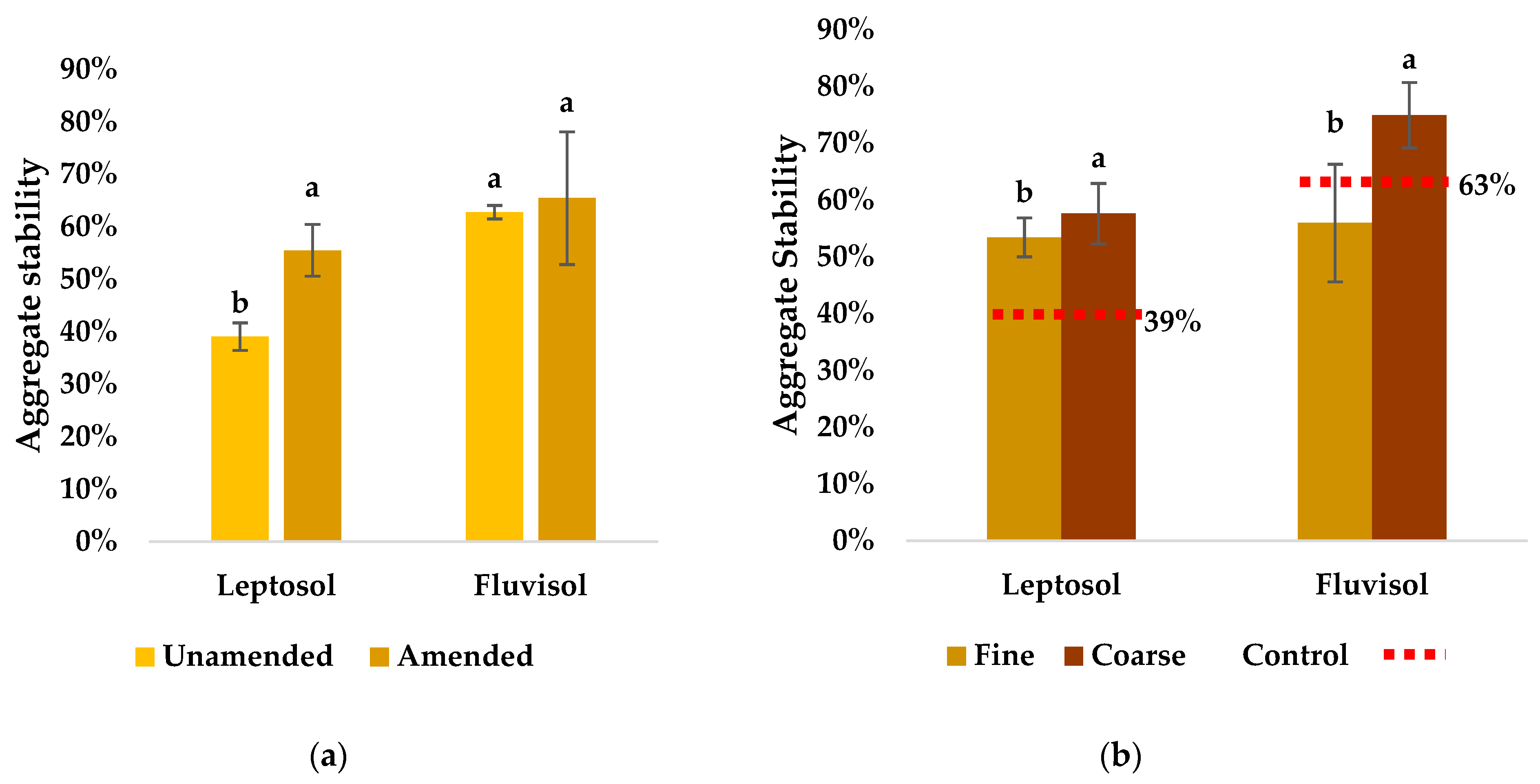
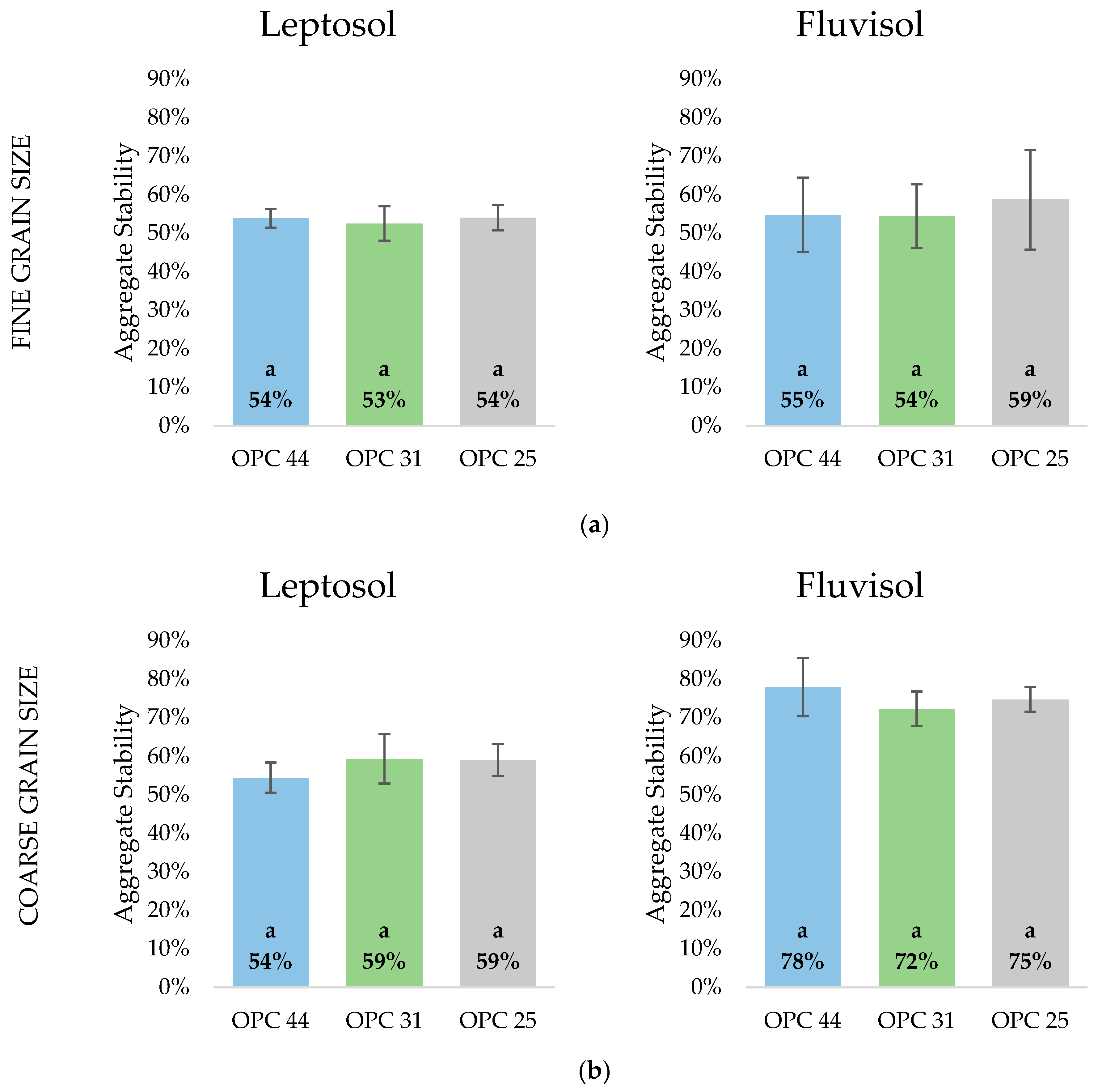
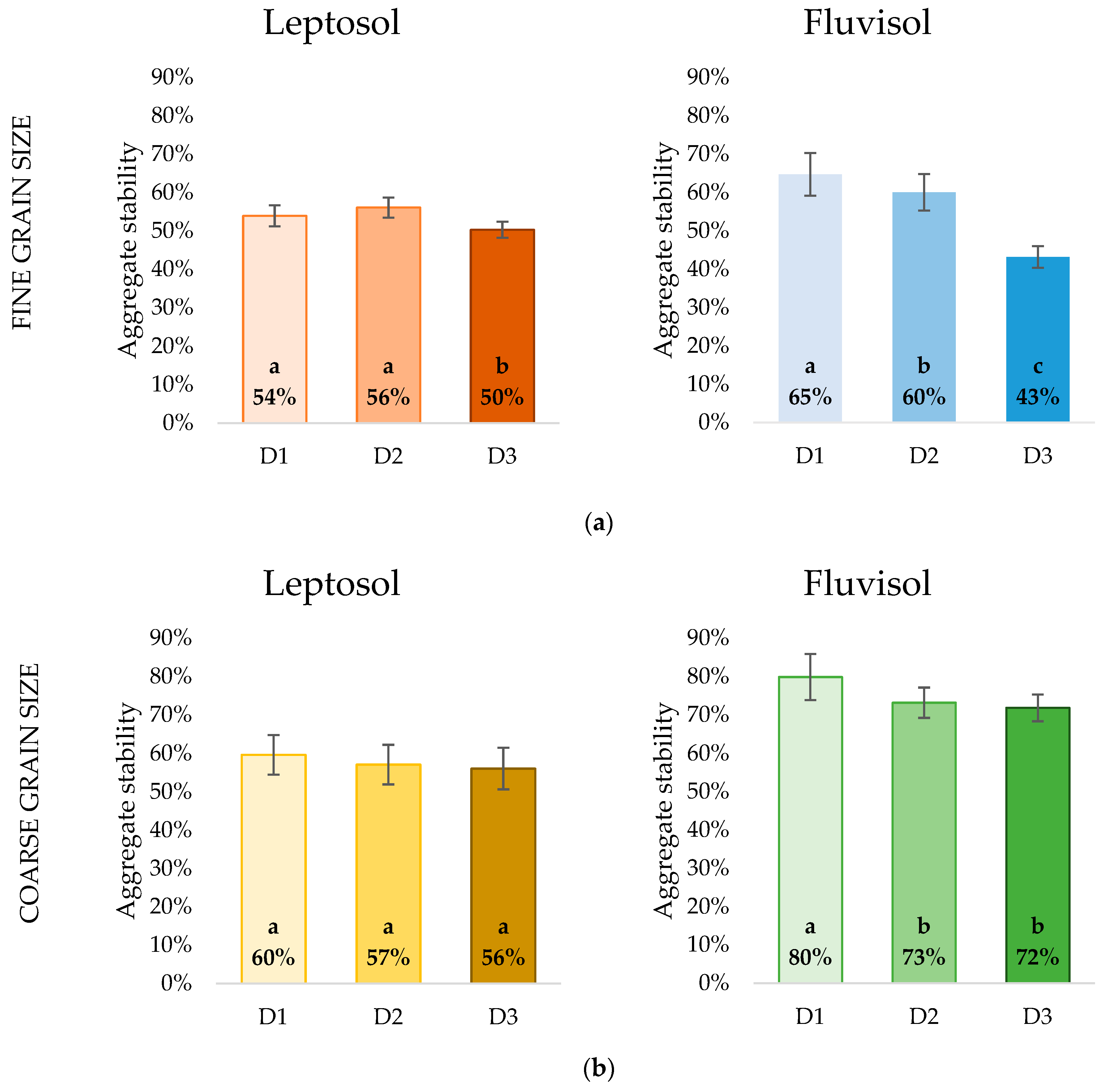
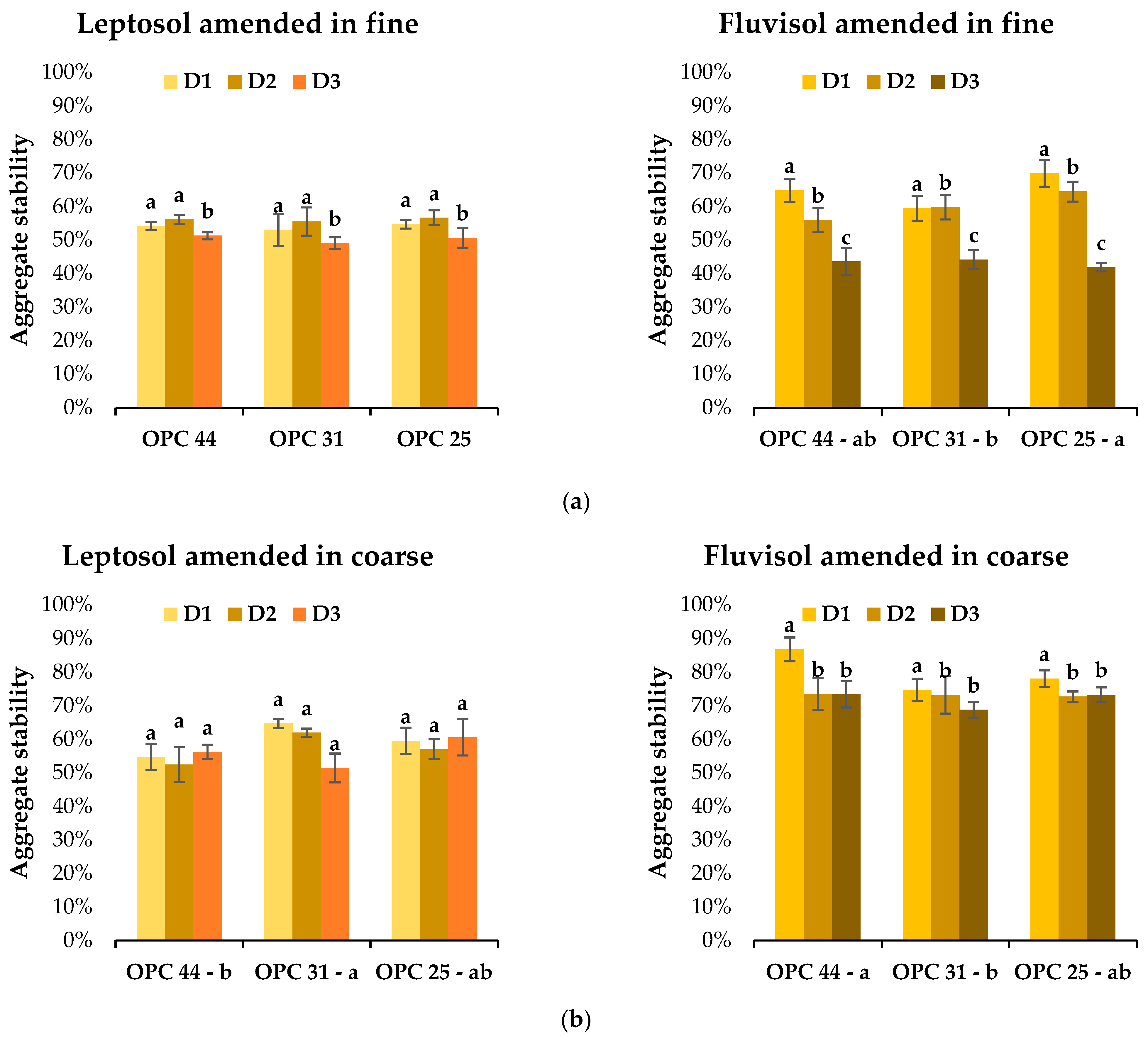
| Soil | Fluvisol | Leptosol |
|---|---|---|
| Texture (ISSS) | Clay loam | Sandy loam to loam |
| Clay (%) | 21 | 12 |
| Silt (%) | 25 | 21 |
| Sand (%) | 54 | 77 |
| OM (%) | 4.2 | 2.1 |
| SOC (%) | 2.4 | 1.2 |
| pH (H2O) | 5.6 | 5.4 |
| pH (KCl) | 5 | 4 |
| EC (25 °C, µS/cm) | 90.3 | 100.6 |
| Total N (g/kg) | 2.3 | 1.5 |
| Effective CEC (cmol+/kg) | 26.64 | 5.8 |
| Potential CEC (cmol(+)/kg) | 33.4 | 10.6 |
| Exchangeable Al (cmol(+)/kg) | 0.012 | 0.007 |
| Olive-Pomace-Based Conditioners (OPC) | OPC 44 | OPC 31 | OPC 25 |
|---|---|---|---|
| Initial ratio olive pomace: sheep manure: almond shell (v/v) | 4:1:4 | 4:1:8 | 4:8:4 |
| C/N | 16 | 17 | 11 |
| OM (%) | 61 | 58 | 36 |
| Total C (%) | 32 | 31 | 19 |
| Total N (%) | 2.1 | 1.8 | 1.7 |
| pH | 8.0 | 7.9 | 9.5 |
| EC (mS/cm) | 1.94 | 2.61 | 5.24 |
| P2O5 total (%) | 0.26 | 0.22 | 0.49 |
| K2O total (%) | 0.94 | 1.13 | 1.87 |
| CaO total (%) | 1.03 | 0.75 | 1.31 |
| ANOVA—Four Way | ANOVA—Three Way per Soil | ||||||
|---|---|---|---|---|---|---|---|
| Factor | p-value | PES * | Factor | Leptosol | Fluvisol | ||
| Grain size | <0.001 | 0.442 | p-value | PES | p-value | PES | |
| Soil | <0.001 | 0.369 | Grain size | <0.001 | 0.215 | <0.001 | 0.758 |
| Dose | <0.001 | 0.259 | Dose | <0.001 | 0.148 | <0.001 | 0.563 |
| OPC | 0.339 NS | 0.016 | OPC | 0.130 NS | 0.060 | 0.085 NS | 0.072 |
Disclaimer/Publisher’s Note: The statements, opinions and data contained in all publications are solely those of the individual author(s) and contributor(s) and not of MDPI and/or the editor(s). MDPI and/or the editor(s) disclaim responsibility for any injury to people or property resulting from any ideas, methods, instructions or products referred to in the content. |
© 2023 by the authors. Licensee MDPI, Basel, Switzerland. This article is an open access article distributed under the terms and conditions of the Creative Commons Attribution (CC BY) license (https://creativecommons.org/licenses/by/4.0/).
Share and Cite
Royer, A.C.; de Figueiredo, T.; Fonseca, F.; Lado, M.; Hernández, Z. Short-Term Effects of Olive-Pomace-Based Conditioners on Soil Aggregation Stability. Agronomy 2024, 14, 5. https://doi.org/10.3390/agronomy14010005
Royer AC, de Figueiredo T, Fonseca F, Lado M, Hernández Z. Short-Term Effects of Olive-Pomace-Based Conditioners on Soil Aggregation Stability. Agronomy. 2024; 14(1):5. https://doi.org/10.3390/agronomy14010005
Chicago/Turabian StyleRoyer, Ana Caroline, Tomás de Figueiredo, Felícia Fonseca, Marcos Lado, and Zulimar Hernández. 2024. "Short-Term Effects of Olive-Pomace-Based Conditioners on Soil Aggregation Stability" Agronomy 14, no. 1: 5. https://doi.org/10.3390/agronomy14010005
APA StyleRoyer, A. C., de Figueiredo, T., Fonseca, F., Lado, M., & Hernández, Z. (2024). Short-Term Effects of Olive-Pomace-Based Conditioners on Soil Aggregation Stability. Agronomy, 14(1), 5. https://doi.org/10.3390/agronomy14010005









